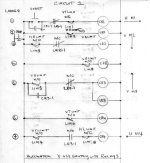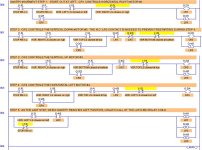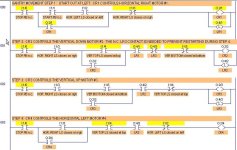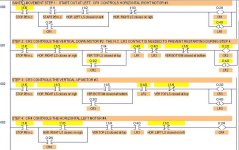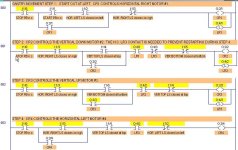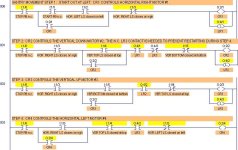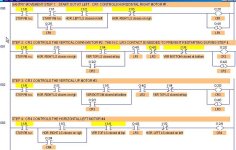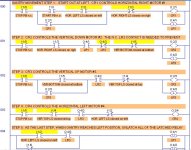Oh I see things have moved on whilst I've been drawing my circuit for 4 motors to drive a vertical and horizontal gantry.
I've not examined yet at what has been posted (I will) but here is my circuit. I does not show how to reset the latch relays.
At the moment I've been seeking to understand what a circuit would look like using just electromechanical relays. Then later I want to examine how you would achieve the same thing with a PLC.
The following is what I wrote in relation to my circuit:
------
After further thought I've produced my circuit for automating vertical and horizontal gantries with 4 DC motors. Pressing Start button initiates a sequence of the horizontal gantry going to right end stop. Vertical gantry then goes down to it's end stop and then goes back to home, then horizontal gantry goes left to home.
CR1 is associated with a motor M1 which takes H gantry right.
CR2 is associated with a motor M2 which takes V gantry down
CR3 is associated with a motor M3 which takes V gantry up
CR4 is associated with a motor M4 which takes H gantry left
I have not shown the motor circuits which may be required to be interlocked.
I hope the circuit I've drawn would pass muster.
I'm making the assumption that once a latch relay is energized any further energizing does not reset the latch contacts.
Here is the explanation:
Ladder #1: Pressing start energizes CR1. Horizontal gantry moves right. CR1-1 seals, so there is continuity after button is released. Lim1 is vertical gantry top limit switch. This ensures CR1 will only be energized if the vertical gantry is at it's top position out of the way of the horizontal gantry. LR1-1 is NC latch contacts associated with LR1.
Ladder#2: When the horizontal gantry hit's right end stop, Lim2, a horizontal gantry right limit switch closes. That energizes latch relay LR1. LR1-1 contacts open and CR1 de-energizes. CR1 can only be re-energized after LR1 is reset. This avoids accidents if Start is pressed accidentally at some inconvenient point to set M1 running.
Ladder#3: Lim3 is a horizontal gantry right limit switch. When the horizontal gantry hits right end stop Lim3 closes energizing CR2. CR2 controls M2 which drives vertical gantry to bottom end stop. LR2-1 are NC latch contacts associated with LR2.
Ladder#4: Lim4 is a vertical gantry bottom limit switch. When the vertical gantry hits bottom stop, latch relay LR2 is energized. Therefore, LR2-1 opens and stays open. This de-energizes CR2 and and thus M2 until a reset of LR2.
LR2 (and not a simple NC limit switch in series with CR2 circuit) is necessary: If there was no permanent break arranged in the circuit, there would be an instance when M2 would be energized when the vertical gantry hit top.
Ladder#5: Lim5 is a vertical bottom limit switch which closes when the vertical gantry hits bottom stop. When that happens CR3 is energized and M3 moves the vertical gantry to the top. CR3 seals Lim5, in order to maintain continuity when Lim5 opens as the vertical gantry moves to the top. LR3 is a latch relay that operates LR3-1 LR4-1 are the contacts associated with LR4.
Ladder6: Lim6 is a vertical gantry top limit switch. When the vertical gantry hits the top end stop, this closes energizing LR4. LR4-1 contacts open CR3 And M5 are de-energized. LR4-1 contacts stay open until LR4 is reset.
Strictly speaking you do probably do not need LR4 and it's contacts. A simple NC limit switch at top end of the vertical end stop will serve to stop M3. For this circuit to be energized again vertical gantry must be in the bottom position which is probably unlikely to happen.
Ladder7. Lim7 is vertical gantry top limit witch, which closes when vertical gantry hits top. CR4 is energized, so M4 drives the horizontal gantry back to home. Lim8 is a horizontal gantry left limit switch which opens when horizontal gantry hits left end stop. Latch contacts LR3-1 only close after CR3 is energized. If this were not the case CR4 would be energized right from power switch on because the vertical gantry is at the top before the Start button is pressed. Also when the vertical gantry is driven to top by M3. So, it is essential LR3 is in circuit.
